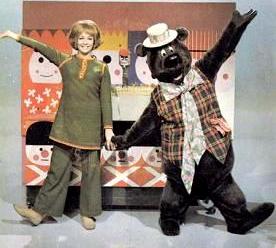Ann North and Humphrey
Humphrey B. Bear
First appearance 24 May 1965 on Children’s TV show The Channel Niners, with hosts Ian Fairweather and Ann North
Humphrey B. Bear is an Australian children’s television series and its fictional character namesake is an icon of Australian children’s television.[citation needed] Humphrey B. Bear was first broadcast on Adelaide’s NWS-9 on Monday, 24 May 1965. The show became one of the most successful programs for pre-schoolers in Australia. The part of Humphrey was originally played by Edwin “Ted” Duryea, (c.1930-2009) an actor, singer and dancer whose human identity was never revealed.
The character of Humphrey is a tall, shaggy honey-loving brown bear with a large, round, shining, glossy black nose, straw boater hat, tartan waist-coat and oversized yellow bow-tie. His television show always features a companion who assists and narrates Humphrey’s various adventures in the “magic forest” including his brightly coloured tree house. The show is shot on television studio set. In the early days the character was known as Bear Bear and was named Humphrey B. Bear as the result of an on-air competition.
The show has won Logies for Best Children’s Series and the Humphrey character has received national awards and commendations, including a special “Citizen of the Year” Award at the 1994 Australia Day celebrations. Humphrey B. Bear has viewers all over the world thanks to the United States version of his show shown on PBS in America and the Spanish version shown on Galavision. It has been translated or produced in 55 different languages.
Each episode of Humphrey is designed to entertain and educate its audience through music and storytelling as they join in the fun with the character of Humphrey B. Bear. Humphrey is a honey-loving bear who lives in his Tree House in the Magic Forest. Humphrey is a friend to everyone and everyone is his friend.
The writers of Humphrey B. Bear, including Anthony O’Donohue (also long time host of the show), attempt to set up each show as a new adventure for Humphrey that parallels the needs, encounters and interests the average young child. The character of Humphrey explores life as they do, trying to reinforce their self-esteem and showing them it’s all right to embrace challenges. The series attempts to show it’s important to be the best that you can be, give things your best shot and to simply take part in your life, family, community and the world.
On 14 February 2007 it was reported that the Nine Network would record a new Here’s Humphrey series for the first time since 2003.
In February 2012, Imagination Ventures, the philanthropic enterprise of media company Imagination Entertainment, purchased the assets of Banksia Productions that included all the rights to the Humphrey B. Bear.
In May 2012 Humphrey was announced as the official ‘Ambassabear’ for the Women & Children’s Hospital Foundation and he was introduced to a new generation of children. His first major fundraising effort saw the release of a limited edition gift set featuring a Humphrey plush doll & DVD with all proceeds supporting the hospitals Kids FUNd program. Since then, Humphrey has reappeared across Australia featuring in live shows including school performances, community events and birthday parties.
In July 2013 Humphrey returned to national TV screens on Television stations in Sydney, Melbourne, Brisbane, Adelaide & Perth.
50th anniversary
Humphrey celebrated his 50th Anniversary in 2015.
Ownership
In September 2016, OZPIX Entertainment facilitated the acquisition of all the assets and rights to Humphrey B. Bear from Imagination Ventures. Imagination Ventures continues to partner with the Humphrey B. Bear brand.
Village Roadshow Studios now play host to Humphrey B. Bear’s new headquarters at their studios on the Gold Coast, Australia.
Humphrey has been recognised as an icon of Australian television and is featured in the Australian National Museum.
He became the only bear in the world to become a cub when he was initiated into the Scouting Movement.
From Wikipedia, the free encyclopedia


